We have seen the future, and the future is mostly blue.
Or, put another way: in our representations of the future in science fiction movies, blue seems to be the dominant color of our interfaces with technology yet to come. And that is one of the many design lessons we can learn from sci-fi.
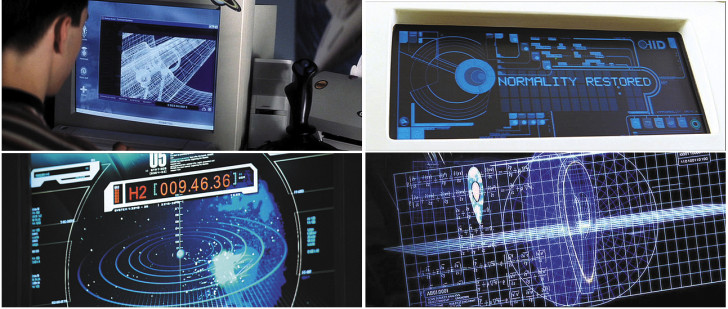
Designers and sci-fi aficionados Chris Noessel and Nathan Shedroff have spent years compiling real-world lessons that designers can, should, and already do take from science fiction. Their book, Make It So: Interaction Design Lessons From Science Fiction is a comprehensive compendium of their findings.
To give you a sense of how exhaustive their research is in this field, take note that the lesson above–future screens are mostly blue–was determined empirically. Shedroff and Noessel catalogued virtually every interface from every sci-fi movie from 1968 through 2011 and determined an average color per year.

So why is blue the chosen color? Noessel posits that, because blue is so rare in nature (if you discount the sky and the ocean, which are arguably not blue) there’s something fundamentally mystical, unnatural, and inhuman about it.
Whether or not screens in the future will, in fact, be blue, is beside the point. Make It So is about applying the ways we conceive of the future to the design of our present moment. After all, if sci-fi is about letting our imaginations run wild and create imagined worlds, then there are plenty of design lessons from looking at the experience of the characters moving through those worlds. Even if your sci-fi world is 1000 years in the future, those choices are in constant dialogue with the present.
Even the first sci-fi film is a sign of its times. In Georges Méliès Le Voyage dans la lune (A Trip to the Moon, 1902), there are hardly any interfaces!
Hence, Science fiction can help us understand what we want in the present. And, when components of science fiction saturate the public imagination, it can affect how we design things. Consider the MicroTAC, one of Motorola’s first cell phones. It did not sell well.
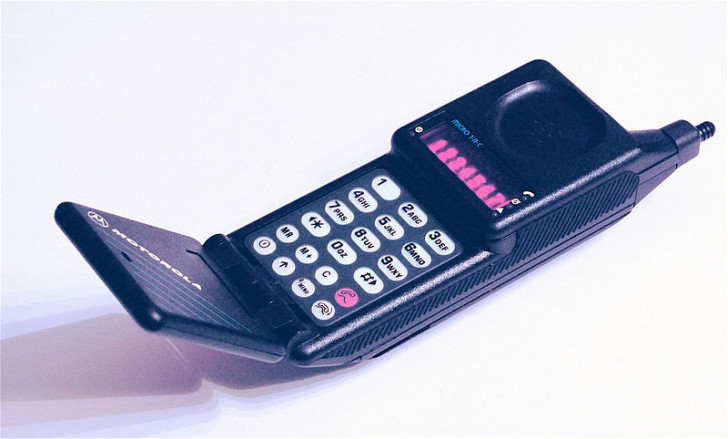
The MicroTAC had a mouthpiece that flipped down. When the Motorola designers took this phone to Argonne National Laboratory for their advice, the Argonne engineers said they had make the phone the wrong way–it ought to open upwards, not downwards. Like on Star Trek.
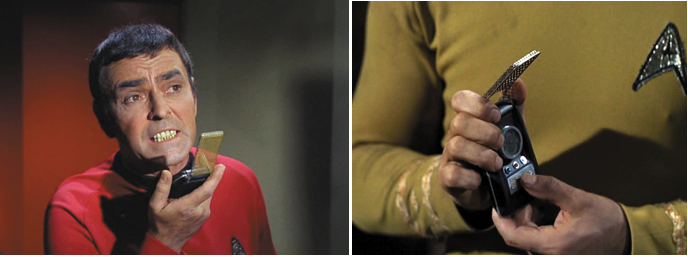
Motorola’s subsequent generation opened upwards. It was wildly successful. It was called the StarTAC.
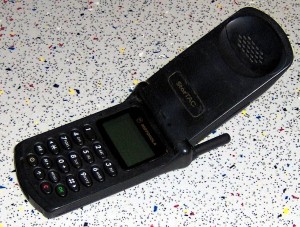
Star Trek also may have helped create the entire image-under-glass paradigm that governs our digital world. The interface, known as LCARS, is cool-looking. It’s distinctive. And it’s actually the result of a budget shortfall.
Star Trek: The Next Generation didn’t have as much money for set design as did the original series, which had panels wired with jewels and glowing buttons. Instead, they cut out film and put them over glass panes.To this day, people still modify their computers and tablets to make them look like an LCARS device from the 24th Century, by way of the late 80s.
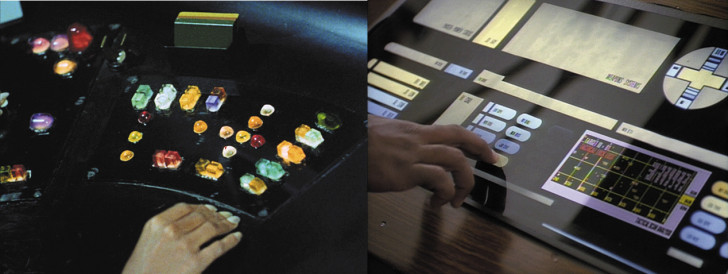
The most interesting lessons from sci-fi come when you assume, for the sake of argument, that everything is in sci-fi is there for a reason–even things that look like mistakes. There’s a word for this, apologetics, which usually refers to the act of attempting to close logical loopholes in theology.
Take Star Wars, for instance, in the scene when Luke and Han Solo are in the Millennium Falcon blowing up TIE fighters.
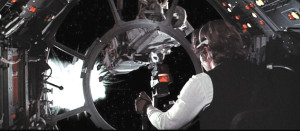
If they’re fighting in the cold vacuum of space, why do we hear the ships exploding? Sound doesn’t exist without air.
George Lucas probably figured that a silent gun fight would probably have been way less dramatic. He wanted to make the scene feel real to the audience, even if it was less true to reality. And if we move from the point of view that what works for the audience will work for the user, we can ask ourselves–could this make sense? Is there an explanation that can warrant hearing ships exploding in space?
Well, what if the sound is the interface? Audio is a much more efficient gauge of surroundings, since it spans 360 degrees, whereas vision only covers 120 degrees. It might be that there are sensors on the outside of the Millennium Falcon that provide 3D sound inside the gunner seat. So when we hear ships blow up, we’re actually hearing an augmented reality interface that Luke and Han hear. Maybe?
Here’s another one. In 2001: A Space Odyssey, Dr. Floyd is on a satellite, making a video call to his daughter back on earth. You see his daughter button-mashing the controls on the video phone, but, strangely you don’t hear any of the buttons.
Maybe the sound designer was sleeping on the job, but this really is the way that phones ought to work. It could be that the system was context-aware enough to acknowledge that its user is a child, and disregard her button-mashing.
With design thinking, there are logical excuses for every interface discrepancy. And it makes sci-fi that much more fun to watch.

Producer Sam Greenspan spoke with Nathan Shedroff and Christopher Noessel, authors of Make It So: Interaction Design Lessons from Science Fiction. Their work continues on their website SciFiInterfaces.com.
All the music in this episode is by OK Ikumi, his album Alpine Sequences is glorious. Get it.



Comments (42)
Share
Such a great episode! Really brought out my inner-geek and -nerd. Thanks for another quality show!
Such a great episode! Couldn’t wait to get home to watch all the film clips and blue screens.
Some random thoughts:
1. The “11th through the door” game actually corresponds to a well known mathematical problem called The Secretary Problem. There’s even a provably optimal strategy, surprisingly involving Euler’s constant e.
http://en.wikipedia.org/wiki/Secretary_problem
2. Google has repeatedly announced that it’s vision for search is derived from the Star Trek computer. This goes further than just an interface, but it seems like an interesting and important case where sci-fi shapes expectation from reality.
http://www.slate.com/articles/technology/technology/2013/04/google_has_a_single_towering_obsession_it_wants_to_build_the_star_trek_computer.html
It would seem logical to me that future user interfaces would be in full colour.
From the title, I thought that this episode was going to be about future computers BSODing. To quote Rick Moranis, “Out of order? ****! Even in the future nothing works!”
I personally like to color all technology related things in my life blue in reference to IBM and it’s nickname “big blue.”
It’s also interesting seeing that most big players online in computers tend to be blue. Facebook, Apple, Twitter, Gmail, even Windows XP.
Scifi analysis and design geekery? Yessss. Bonus points for mentioning male gaze and gender binary. :)
Quote : (Queen Amidala uses the same button to route a hologram across the galaxy, and call up a star chart, and land a space ship. Massive design oversight? Or could this be the “make it so” button? Star Wars Episode I: The Phantom Menace (1999) 20th Century FOX)
Can it be the equivalent of the “Enter” key on a keyboard, or some kind of choice validation?
Anyway, I really like the idea of being aware of design in sci-fi :)
Part of the reason for blue in high tech in films is that blue appears to recede. It usually makes a good background. And the people are warmer, almost orange (no matter what ethnicity), so they “pop” from the screen more. It’s often referred to as the “Hollywood palette.” Films are filled with a lot of teal and orange.
Another theory: Blue is “cold” and technical, in contrast to humanity, which is “warm.” Blue is sometimes used to symbolize “reality” and warm colors are often for memories, better days, dreams and romance.
I’m blue abudiabudai :(
Good episode with brilliant music.
If anybody cares for something similar I highly recommend the Soundtrack for Tokyo Sonata by Kazumasa Hashimoto. Hashimoto’s sound is more autumn rainy day than OK Ikumi but nevertheless similarly brilliant.
Also the movie is good too as it has Teruyuki Kagawa…
Just upped my pledge for Radiotopia.
Keep up the good work
You’ve gotta love the typeface on 2001. If you’re into graphic design, the font is called Microgramma
Very distinctive and probably the most accurate futuristic style.
Star Wars uses that explanation for hearing sound in space in the novelization for A New Hope. Which actually came out before the movie, since Alan Dean Foster writes very quickly. I’m not sure it really counts as ‘apologetics’ when the explanation appears first.
Is not the Pacific Ocean blue? In terms of not much real blue in the natural wold….cannot think of many things bigger. We can never come close to creating a stronger more beautiful blue than that!
Folks looking for a lighter take on the problems of designing for an imagined future might want to screen “Desk Set,” a romantic comedy from 1957 starring Tracy & Hepburn. It concerns a group of researchers at a national network (a thinly disguised NBC) who fear being replaced by an “electronic brain” named EMERAC. Although its name is very similar to the University of Pennsylvania’s ENIAC, EMERAC is really more like Remington Rand’s UNIVAC—the first widely available mainframe.
Considering the fact that this “sci-fi” is set, not in a world centuries beyond the Eisenhower era, but in a world we can now easily recognize as the mid-1960s, it’s amazing how much the writers, designers and set decorators got wrong. By the late ‘50s, it was already apparent that transistors would make mainframes ever smaller, yet EMERAC is gigantic, easily dwarfing every other element on the set. Granted, the size of EMERAC may have more to do with the idea that technology was a huge threat to the “ladies” of the research department. Its size was merely the physical embodiment of what the electronic revolution would mean to people who earned their livings with pencils and paper.
In spite of the laughable beeps, boops and groans emitted by EMERAC (at one point it actually vents steam), a critical scene absolutely nails what the computer/Internet revolution would mean to clerks and librarians. The president of the network challenges the researchers to retrieve an obscure statistic about damage to U.S. forests caused by the spruce bud worm. We’re informed in an aside that it had taken weeks to find the information with traditional, library-based methods. The nerdy mistress of EMERAC sits down at a keyboard and types in: “How much damage is done annually to American forests by the spruce bud worm?” Almost instantaneously EMERAC spits out the answer.
The original Broadway playwright, William Marchant, clearly saw where the world was headed, because we all do pretty much the same thing every day with Google.
Pretty sure those screencaps are from Attack of the Clones and Revenge of the Sith. Amidala wears a white adventuring suit when she leave Tatooine for Geonosis and a brown sleeve when she travels to Mustafar to confront Anakin.
Does anyone know the title of the song that plays while Roman is talking about the kickstarter campaign and Radiotopia? It sounds like a cover of Perpetuum Mobile by the Penguin Café Orchestra, but I can’t seem to find it and it’s not on the OK Ikumi album mentioned.
I’m surprised that the similarity between the Circuit in Logan’s Run and the dating app Tinder wasn’t mentioned in the podcast.
I once tried to design screens for a fairly well known scifi show that weren’t all blue…the producer saw it and while he said my designs were cool…they weren’t blue. Blue is the color. It is all blue. GO BLUE!!!
Here’s the track at the end… https://soundcloud.com/ok-ikumi/jack-nitzsche-starman-leaves :)
Yeah I was a little bummed that Roman didn’t give credit where it was due. The music is just a remix of Jack Nitzsche’s score for the film Starman.
An apologetic for the Queen Amidala button could be a mental uplink. I way to connect your thoughts to the computer to pull up the particular interface you are thinking of. You wouldn’t want all of your thoughts being displayed all willy-nilly so this would give you control over when your thoughts are used. Head (minus the phone) jack.
Loved this installment. I hope apologetics gets it’s own coverage in the future.
I couldn’t help yelling back at the podcast coverage of the StarWars single button example. That is the iphone……what Queen has a fancy ship without active listening systems? The button knew what to do because it was following her conversation. Didn’t anyone notice she talks about it BEFORE she hits the button? It was a long time ago in a galaxy far far away but if you got warp drive your definitely ahead of us linguistic software capabilities.
Great episode!
But is blue light bad for us?
http://www.health.harvard.edu/newsletters/Harvard_Health_Letter/2012/May/blue-light-has-a-dark-side/
Excellent episode, guys! Reminded me somewhat of an awesome article from The Awl about “pictures-under-glass” interfaces: http://www.theawl.com/2013/02/how-minority-report-trapped-us-in-a-world-of-bad-interfaces
The last bit is the best:
“Hopefully one day we’ll reach the point where filmmakers don’t want computers to look like conducting an orchestra, and we’ll be able to back out of this interface cul-de-sac and find our way forward into a genuinely natural way of using our devices. Like porn, techno interfaces are more focused on what looks good than what feels good. And like porn, it’s pretty hard to get people to stop buying. Here, I’ll make a deal: If we’re gonna be focusing all our cultural attention on something so impractically sexy, can it be jetpacks instead?”
Curious for an audio podcast about interfaces to completely ignore the audio that seems to accompany almost every computer display in film and tv. Who ever had a monitor which also output a beep or a dot-matrix printer sound for every character displayed? I’m sure I’m not the only one to roll my eyes evey time some drama series focuses on the monitor as it painfully clicks/beeps out every letter. Surely as a visually-dominant species we don’t need the added audio prompt to draw our attention.
Surely the StarTAC design and the Star Trek communicator design are dictated by a shared universal fact of human biology: it’s a lot easier to flip something open with your thumb than with your pinky.
+1 Nitpicker. Sweet obscure factoid.
Exceptional episode, even by the high standards for 99pi.
Love this show.
Surely they’re blue because blue is the colour we associate with electricity…
blue is also the (perceived) color of the sky, surely the most dominant thing in the field of vision of every hominid ever.
Another possible interpretation of the Queen Amidala conundrum is that the button is responsible for executing non-spoken commands that the individual is thinking. This would be somewhat consistent with the “Make It So” explanation but with a slight twist. While I’m not aware of telepathic computers existing in the world of Star Wars, this would be an potentially important button in a world where such technology could exist. Without a conscious action on the part of the human user to confirm a thought to computer action, a computer could try to carry out every thought of the user, with potentially illogical or even disastrous consequences.
If you look at the screenshots for the Queen Amidala example,the screen to the right is different in each scene. What if that single button preformed a different action each time because the computer was in a different mode each time??
As an accompanying blog post, here’s a review of the typography used in 2001: A Space Odyssey. Really cool to have these together. http://typesetinthefuture.com/2001-a-space-odyssey/
Expanding on Lucas Picador’s comment:
It’s a lot easier to type on a phone keypad if you don’t have a big piece of plastic in the way. Any half-decent designer would have figured that out, and it’s most likely the cause of the design change – not Star Trek!
I find the hasty definition of non-scifi apologetics to be lacking. The practice of apologetics is explanation period, not just explaining AWAY logical holes. Of course, bad apologetics IS just explaining away logical holes, but that is not all the study is.
Cool episode. Concerning lesson 6, check out “Her”, very interesting SF design :).
I’d speculate the widespread future GUI for glass displays might be figure ground, gestalt, white (full spectrum) on glass. White seems to be a normal starting point (most contrast), and any other color variation is mood suggestive, so biased.
Some of the most compelling ones I’ve seen in sci-fi have been white light.
Have you noticed how many SF movie consoles don’t have labels? The Star Trek screencap you’ve used has two dozen unlabeled buttons on just that small portion of the console. I think in The Last Starfighter the consoles in the Kodan Armada ships consist mainly of literally hundreds of unlabeled triangular orange buttons. What, are you just supposed to remember what button does what?
Blue certainly was in the ancient world. We have many pieces of antiquity from the 2500 BCE https://en.wikipedia.org/wiki/Blue#History But it was very expensive to produce. The issue is maybe Greece didn’t have a word for blue, but we have blue as in the sky from Egypt.
RadioLab episode was awesome and I just think that it missed the boat a bit. It is almost certainly true from some that didn’t have the color blue we can’t say all and Egypt was a predominate member of Ancient Near East society.
Hitchhiker’s Guide doesn’t take place in the future.
Actually, I think you missed something.
It’s not that the screens are blue, the movies are blue. Blue and Orange.
http://priceonomics.com/why-every-movie-looks-sort-of-orange-and-blue/
You state that the old Star Trek had more money than the new one? The original series was made by Desilu, and their budget was tiny – much less than I love Lucy, the only other show Desilu had at that time. Where did you get this information?
The “make it so” button concept reminds me of a tidbit I learned in the commentary track of the TV show Firefly: Alan Tudyk, who plays the pilot Wash, said that any time another character told him to do something, there were four switches above his head that he would flip before he did the actual action.